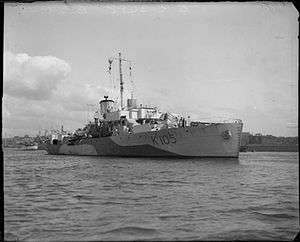HMS Loosestrife
HMS Loosestrife (K105) was a Flower-class corvette of the Royal Navy which sailed with the North Atlantic convoys of the Second World War.
 HMS Loosestrife | |
| History | |
|---|---|
| Name: | Loosestrife |
| Ordered: | 1939 |
| Builder: | Hall, Russell & Company |
| Laid down: | December 1940 |
| Launched: | 25 August 1941 |
| Commissioned: | 25 November 1941 |
| Decommissioned: | 1945 |
| Fate: | Sold into civilian service, 7 October 1946 |
| General characteristics | |
| Class and type: | Flower-class corvette (original) |
| Displacement: | 925 long tons (940 t; 1,036 short tons) |
| Length: | 205 ft (62.48 m)o/a |
| Beam: | 33 ft (10.06 m) |
| Draught: | 11.5 ft (3.51 m) |
| Propulsion: |
|
| Speed: | 16 knots (29.6 km/h) |
| Range: | 3,500 nautical miles (6,482 km) at 12 knots (22.2 km/h) |
| Complement: | 85 |
| Sensors and processing systems: |
|
| Armament: |
|
Construction
Loosestrife was ordered from Hall, Russell & Company in 1939. She was laid down in December 1940 and launched on 25 August 1941. She was commissioned on 25 November 1941.[1]
Career

Loosestrife sailed with Convoy ONS 5 (outward, northbound, slow) from Britain to North America in 1943. The convoy was made up of 42 ships, of which 12 or 13 were sunk after the convoy came under sustained attack from German submarines hunting in packs.[3] On 5 May at 02:25, Bristol City was south of Greenland and east of Newfoundland when it was sunk by a torpedo fired by the German submarine U-358, under the command of Rolf Manke. Fifteen of the 44 people on board died.[4] Manke attacked and damaged Wentworth not long after. Loosestrife picked up the survivors from both sinkings who were landed at St. Johns in Newfoundland.[5][6][7]
On 6 May 1943, Loosestrife sank German submarine U-192 in the North Atlantic south-east of Cape Farewell using depth charges (Lt. Herbert Arthur Stonehouse, RNR, commander).[1] The entire crew of 55 died.
On 4 October 1946, Loosestrife was sold. She subsequently became the merchantman Kallsevni in 1947.[1]
References
- Helgason, Guðmundur. "HMS Loosestrife (K 105)". Uboat.net. Retrieved 1 November 2015.
- "Commander of Corvette which attacked Atlantic Boat Pack. 15 April 1943, Londonderry". Imperial War Museum. Retrieved 4 September 2017.
- Helgason, Guðmundur. "Convoy battles ONS-5". Uboat.net. Retrieved 30 October 2015.
- Helgason, Guðmundur. "Bristol City". Uboat.net. Retrieved 30 October 2015.
- Offley, Edward (2012). Turning the Tide: How a Small Band of Allied Sailors Defeated the U-Boats and Won the Battle of the Atlantic. New York: Basic Books. p. 300. ISBN 978-0-465-03164-1.
- Malcolm, Ian M. (2013). Shipping Company Losses of the Second World War. Stroud: History Press. p. 53. ISBN 978-0-7509-5371-9.
- Syrett, David (1994). The Defeat of the German U-boats: The Battle of the Atlantic. Columbia: University of South Carolina Press. p. 80. ISBN 978-0-87249-984-3.
Publications
- Colledge, J. J.; Warlow, Ben (2006) [1969]. Ships of the Royal Navy: The Complete Record of all Fighting Ships of the Royal Navy (Rev. ed.). London: Chatham Publishing. ISBN 978-1-86176-281-8.